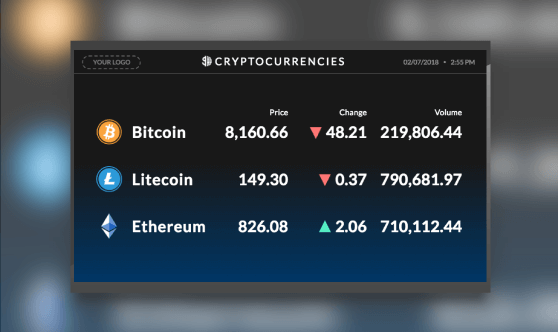
Financial Literacy Labs have become more popular across high schools each year. Creating one on a budget is easier than you think! Here’s how.
To help you get started with your Financial Literacy Lab, we’ve put together a list of 75 terms your students should know.
If you already have a lab up and running, we have financial literacy templates you can add to your displays.
Add template to your digital signage

Add template to your digital signage
Add template to your digital signage
Add template to your digital signage
Active management
The use of humans (vs. automated computers) to manage a fund’s portfolio; it relies heavily on a manager's ability to buy and sell investments by relying on research, forecasts, and their own judgment.
1. Actuary
A person that produces / analyzes stats and uses them to figure out the risks and premiums of holdings.
2. Annual rate of return
The return of an investment over a period of time, and expressed as a time-weighted annual percentage.
3. Annual report
The yearly report from a company to its shareholders; it documents its activities and finances in the previous year.
4. Annuitant
A person who gets an annuity.
5. Annuity
The fixed sum that is paid to someone each year--often for the rest of their life. For example, a will might leave a grandchild an annuity of $1,000.
6. Appreciation
An increase in the value of an investment.
7. Asset
An item that carries economic value to a person or corporation. Examples include stocks, bonds, and cash.
8. Automatic asset rebalancing (AAR)
A system of automatically making adjustments to a person's portfolio to counteract performance differences over time. For example, a person’s portfolio might invest 50%, 40% to stocks, and 10% to short term investments; if the portfolio starts to trend in a particular direction, AAR would change the allocation of the investment so it continues to perform at the same rate.
9. Average annual total returns
The percentage that is used when reporting the historic return--such as the 3, 5, or 10 year average.
10. Basis point
The common unit of measurement for interest rates (or other finance percentages).
11. Benchmark
How the performance of an investment is measured.
12. Bond
A fixed investment where the investor knows the interest that will be received. Unlike stock, bonds have an end date and terms that detail the variable or interest that will be paid.
13. Broker
The person (or entity) that buys investments for you.
14. Capital gain
When the value of an asset is worth more than the purchase price. The “gain” is not made until the asset is sold.
15. Capital loss
The opposite of a capital gain; the asset is worth less than the purchase price.
16. Cash alternative / cash equivalent
Low risk, low return investments that are used in short-term investing; money markets are an example of this type of investments.
17. Cash refund annuity
Refunds to a beneficiary for any amount of money that is still owed to an annuitant if they die before the premium has been paid.
18. Class A shares
A type of common stock that gives the owner more voting rights then Class B; this type of stock is typically given to management at the company.
19. Class B shares
Typically, this type of share is more accessible for purchase but carries less voting rights.
20. Class C shares
A class of mutual fund stock.
21. Class Y shares
Institutional shares that frequently have a very high minimum investment ($25,000 or more).
22. Class Z shares
Class of mutual fund shares that is for employees of the fund. Shares are also offered to employees as compensation packages.
23. Commission
The amount of money charged by a broker / investment adviser in return for either providing advice or handling the purchase of assets.
24. Common stock
A type of security that gives the holder ownership in a corporation.
25. Compounding
This happens when the earnings from a person’s assets are reinvested in an effort to generate additional earnings.
26. Credit risk
Determines the likely “risk” of a person or entity not being able to repay a loan or fulfill the obligations that is outlined in a contract.
27. Current Yield
The annual income from an investment (either from interest or dividends) divided by the price of a security.
28. Custodian
The person (or entity--such as a bank) that is responsible for holding onto the financial assets.
29. Deferred annuity
An annuity that delays income / payments until the investor decides to receive them.
30. Deflation
The decline in price for a good or service.
31. Depreciation
An accounting method where the cost of an asset is determined over time to account for a decline in value. It is commonly used for expenses such as computers, which will be worth less over time.
32. Distribution
Type of transaction that occurs when the volume of a security is greater than the previous day without any price increase.
33. Diversification
A risk management technique that mixes several types of investments into a portfolio; the goal is the minimize the risk while maximizing the return.
34. Dividend
A distribution from a portion of a company's earnings that is paid to its shareholders; dividends are decided by the board of directions of the company and must be approved by the shareholders.
35. Duration
Measures the sensitivity of a share price to a change of interest rates.
36. Earnings
The after-tax income of a company's profits.
37. Emerging market
Markets that emerge from developing countries that have traditionally relied heavily on agriculture and exporting raw materials.
38. Equity
Determined by taking the assets and subtracting the liabilities.
39. Exchange traded fund (ETF)
A security that tracks a stock index, commodity, bond, or other assets.
40. Expense ratio
Measures how much of a fund is used for operating expenses or other administrative type fees.
41. Federal Deposit Insurance Corporation (FDIC)
An independent federal agency that insures deposits at U.S. banks in the event of bank failures.
42. Fiduciary
A person who represents another person to manage their assets.
43. Financial statement
Written records to show the financial conditions and/or activities of a business.
44. Fixed annuity
An annuity contract that allows capital to increase on a tax-deferred base.
45. Front-end load
A commission or sale applied at the time of purchase of the investment.
46. Government securities
A bond that is issued by a government body with the promise of repayment at maturity. They are considered low-risk.
47. Index
The measurement of change in a securities market or segment. The S&P 500 is an example of an index. Indexes cannot be directly invested in.
48. Individual Retirement Account (IRA)
Retirement accounts that you own and contribute to; there are two common IRA accounts:
-
Traditional IRA - Contributions are pre-tax and earnings are tax-deferred; this means no taxes are owed until money is withdrawn.
-
Roth IRA - Contributions are made after-tax; this means you don’t pay taxes as it accumulates.
49. Inflation
The measure of rates which the price of goods or services increases.
50. Interest / Interest rate
The charge for borrowing money.
51. Large capitalization (Cap)
Any company with a value of over $10 billion.
52. Market capitalization (Cap)
The total dollar value of a company’s outstanding shares. It is calculated by multiplying a companies shares to the current price of a single share. For example, a company with 30 million shares that are trading at $100 would have a market cap of $3 billion.
53. Market risk
The possibility of an investor losing money due to factors that affect the financial market they are involved with. Factors may include political change, interest change, or terrorist attack.
54. Maturity date
The date that the principal amount of an investment becomes due and is repaid to the investor.
55. Mid capitalization (Cap)
A market capitalization that is between $2 billion and $10 billion.
56. Money market fund
A mutual fund that only invests in securities with high credit ratings.
57. Mutual fund
An investment that is made up of a collection of money that is pooled from several investors. They are operated by professional money managers.
58. Net asset value (NAV)
The net value of an entity; it is calculated by taking the total value of the entity’s assets and subtracting the total value of its liabilities.
59. Operating expenses
An expense that incurs to a company through a normal business operation.
60. P/E ratio
The ratio for valuing a company; it measures the current price of the share against its per-share earnings.
61.Portfolio
A grouping of different financial assets (stocks, bonds, cash equivalents, etc); portfolios are constructed based on risks and objectives.
62. Principal
The money that you have contributed to your financial account.
63. Qualified / Nonqualified
Qualified contributions have not been taxed yet; nonqualified contributions have been taxed.
64. Return
The money made (or lost) off of an investment.
65. Rider
A provision to a policy that adds (or amends) the coverage of the terms--usually at an additional cost.
66. Risk
The likelihood that the outcome of an investment will be different from the expected outcome. It calculates how likely it is that a person will lose money off the original investment.
67. Securities and Exchange Commission (SEC)
An independent agency of the United States government that enforces federal security laws, and proposes new rules and regulations on the industry.
68. Security
A financial instrument that represents the ownership position in a company.
69. Share
Units of ownership in a company.
70. Shareholder
The person (or entity) that owns stock in a company.
71. Small-cap stocks
Publicly traded companies that have market caps ranging from $300 million to $2 billion; they typically have higher stock prices and less available shares, which makes them “small.”
72. Stock
The capital that has been raised by a corporation from the issue of shares in its company.
73. Ticker symbol
Symbols (typically an abbreviation of a companies name) that represent a company that is traded on an exchange. The ticker symbol for Google, for example, is GOOGL; the symbol for Apple is AAPL.
74. U.S. Treasury securities
A type of debt instrument issued by the United States Department of Treasury to fund different types of government spendings. It is essentially an I.O.U. from the United States Government. There are four types of securities offered: Treasury bills, Treasury notes, Treasury bonds, and Treasury Inflation Protected Securities (TIPS)
75. Volatility
The amount and frequency of fluctuations in the price of a security, commodity or market within a specified time period. Usually, the higher the volatility, the higher the risk.
BONUS - 76. Withdraw
Anytime funds are removed from an investment; it often includes penalties.
BONUS - 77. Yield
The earnings that are generated from any kind of investment over a set amount of time.









